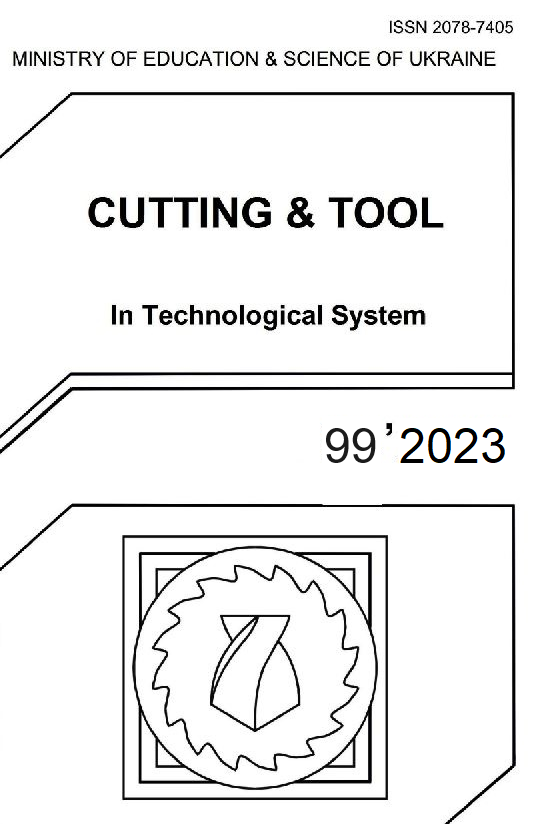ARITHMETIC MEAN HEIGHT AND MAXIMUM HEIGHT OF THE ROUGHNESS PROFILE IN HONING WITH DIFFERENT FEEDS
DOI:
https://doi.org/10.20998/2078-7405.2023.99.03Keywords:
arithmetic mean height of roughness profile, cutting, experiments, honing, maximum height of roughness profileAbstract
The achievable surface quality is an important factor even in roughing procedures; however, it is most relevant in finishing. Two commonly measured and analysed characteristics of the machined surface roughness profile are the Arithmetic Mean Height and the Maximum Height of the Roughness Profile. In this paper these parameters were studied in bore honing. Cutting experiments were carried out, where the feed rate and the applied honing tool are varied. After the evaluation of the measured 2D surface profiles, the following conclusions were drawn: the effect of the feed rate is not linear; the lowest values of the analysed roughness parameters were achieved by the application of 50 mm/rev. feed rate and a honing tool with 80 grain size and ceramic binder; the difference between the studied roughness parameters was 6.5-8.0-fold.
References
Sapit, A. B., Shather, S. K., & Abed, F. N. (2020). Enhancement of the performance surface roughness of wire cutting process by additives Nano [AL2O3]. Periodicals of Engineering and Natural Sciences, 8(2), pp. 933–941.
Ferencsik, V., & Varga, G. (2022). The effect of burnishing process on skewness and kurtosis of the scale limited surface. Rezanie I Instrument V Tehnologiceskikh Sistemakh / Cutting And Tool In Technological Systems, (97), pp. 83–90.
Ferencsik, V., & Varga, G. (2022). The Influence of diamond burnishing process parameters on surface roughness of low-alloyed aluminium workpieces. Machines, 10(7), 564.
Nagy, A., & Varga, G. (2022). Analyzing the effect of the tool pass number and the direction of sliding burnishing on surface roughness. Rezanie I Instrument V Tehnologiceskikh Sistemakh / Cutting And Tool In Technological Systems 97 pp. 70–82.
Kundrak, J., Fedorovich, V., Pyzhov, I., Ostroverkh, Y., & Pupan, L. (2022, September). Numerical Simulation of Grain Concentration Effect on Output Indicators of Diamond Grinding. In Grabchenko’s International Conference on Advanced Manufacturing Processes (pp. 165–175). Cham: Springer International Publishing.
Yang, C. Y., Wang, Z., Su, H., Fu, Y. C., Zhang, N. H., & Ding, W. F. (2023). Numerical analysis and experimental validation of surface roughness and morphology in honing of Inconel 718 nickel-based superalloy. Advances in Manufacturing, 11(1), pp. 130–142.
Szabó, O. (2014). Examination of material removal process in honing. Acta technica corviniensis – bulletin of engineering, 7, pp. 35–38.
Sabri, L., Mezghani, S., El Mansori, M., Zahouani H. (2011). Multiscale study of finish-honing process in mass production of cylinder liner. Wear, Volume 271, Issues 3–4, pp. 509–513.
Kundrák, J., Fedorovich, V., Markopoulos, A. P., Pyzhov, I., & Ostroverkh, Y. (2022). Theoretical Assessment of the Role of Bond Material during Grinding of Superhard Materials with Diamond Wheels. Machines, 10(7), 543.
Goeldel, B., El Mansori, M., & Dumur, D. (2013). Simulation of roughness and surface texture evolution at macroscopic scale during cylinder honing process. Procedia CIRP, 8, pp/ 27–32.
Fedorovich, V., Fedorenko, D., Pyzhov, I., & Ostroverkh, Y. (2021). Modeling the influence of metal phase in diamond grains on self-sharpening of grinding wheels on ceramic bonds. Rezanie I Instrument V Tehnologiceskikh Sistemakh / Cutting And Tool In Technological Systems, (94), pp. 92–101.
Lavrinenko, V., Fedorovich, V., Ostroverkh, Y., & Solod, V. (2023). Modern developments related to the directed impact on the cutting surface of a diamond abrasive tool and its contact zone in the processes of machining. Rezanie I Instrument V Tehnologiceskikh Sistemakh / Cutting And Tool In Technological Systems, (98), pp. 13–29.
Downloads
Published
Issue
Section
License
Copyright Notice
Authors who publish with this Collection agree to the following terms:
1. Authors retain copyright and grant the Collection right of first publication with the work simultaneously licensed under a Creative Commons Attribution License that allows others to share the work with an acknowledgement of the work's authorship and initial publication in this Collection.
2. Authors are able to enter into separate, additional contractual arrangements for the non-exclusive distribution of the Collection's published version of the work (e.g., post it to an institutional repository or publish it in a book), with an acknowledgement of its initial publication in this Collection.
3. Authors are permitted and encouraged to post their work online (e.g., in institutional repositories or on their website) prior to and during the submission process, as it can lead to productive exchanges, as well as earlier and greater citation of published work.

